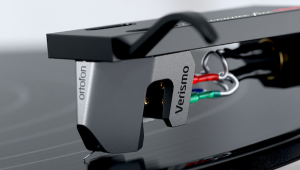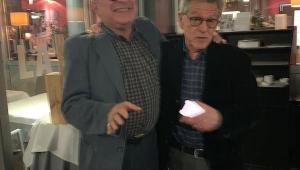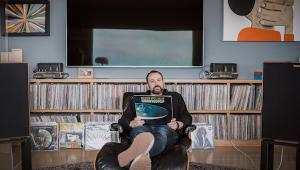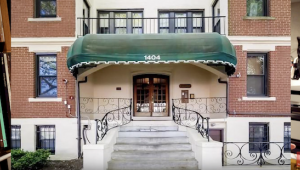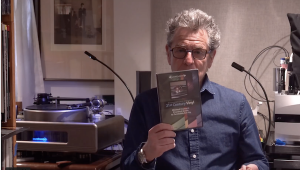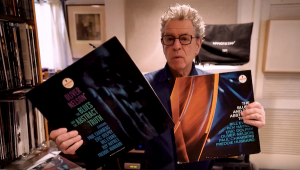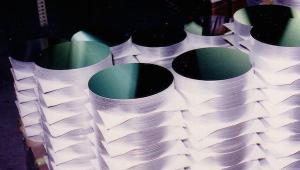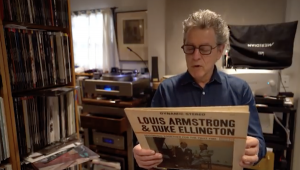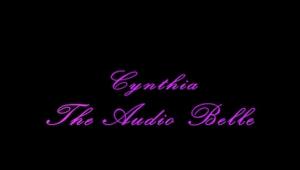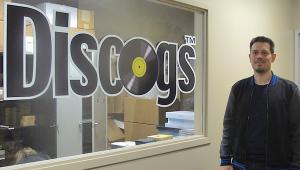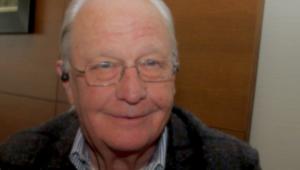Bob Irwin on The Byrds and the 'Planes Part 2
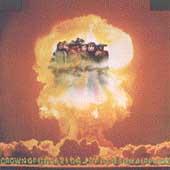
BMG’s 2003 Jefferson Airplane Reissues
Q: Is this, in fact, the very first time the albums have been digitally re-mastered from the original multi-track masters?
A: No, but I’ll tell you what they are. There were some mixes that I used the multi-tracks for and I’ll get to that, but these are re-mastered from the original two-track masters. In all honesty, I’d love to put that feather in my cap, but those masters have been used before; although I can’t speak for the very first editions of CD’s that came out in the ‘80’s…
Q: Those suck….they’re horrible.
A: Okay, well I have no idea what was used there. Now, I may be jumping ahead of the game here, but the important part to mention about those here is that even though the original two-track masters had been used before – and I say this with all due respect to my peers – in each successive use and re-mastering, they got further and further away from the original sound of the albums. These records had very, very deliberate sounds. For example, After Bathing At Baxter’s: we all know what that album is about; it’s a wild and wildly experimental album where a lot of the things that went into the pot to make that an experimental album – no pun intended (laughter) – the original mix reflected that. The original vocals were…not ‘buried’ in the mix, but were way down in the mix compared to what had come before. Now, with each successive re-mastering, people were taking liberties with EQ and different things to try and bring those vocals out, when that’s not the way that album is supposed to sound. So, it’s probably the most precarious re-mastering situation you can be in, to be in a project that’s already been done three times previous. You have a choice to make.
It would have been easy for me to put the tapes up and do yet more to them, and try and make them sound different yet again, so that people would put them in their players and say, ‘Oh my God, listen to how much top end there is here!’. Conceptually, early on, consulting with Bill Thompson, the Airplane’s manager, Rob Santos of BMG and the band members, I said, ‘The right thing to do here, and the thing that I want to do here is to restore them to the way they should sound—the way they sounded on the original records. Those were great sounding records – incredible sounding records. Listen, with Rick Jarrard’s production on Surrealistic Pillow and Dave Hassinger’s engineering…I mean, who has the right to fuck with that?!
So my job was to restore, and keep them as close to the original as I could because, again, those albums when they came out were great sounding records, no matter how you slice and dice it. When you have a chance to work with original masters, it gives you more to work with intrinsically than was captured on vinyl. I mean, you can gain just by using those original masters and not screwing around with them much more than you can by having them and screwing around with them. Also, all the original cutting notes were intact; you know, which songs had to come up in level and ‘…put the left channel half a dB up on this song..’ etc., all that stuff was there. So, as far as it comes to doing the actual album ‘bodies’, it was restoration and following the original notes and not taking liberties.
Q: It’s amazing that all of that was there…
A: Yeah, and in wonderful shape…there wasn’t a part that was missing.
Q: Did you have to bake any of the tapes?
A: No, this was all pre-that time. You only start getting into those problems until about the early to mid-70’s and on. These were all recorded with Scotch stock tape; the tapes were in just fine shape.
Q: How did the condition of the tapes differ from album to album?
A: Not in terms of ‘condition’ per se, but I had also brought in every single multi-track for these albums here in the studio…
Q: Oh, so you had those at your disposal as well as the two-track masters…
A: Oh yeah! I won’t stop until every rock is turned over. I mean we’re talkin’…there were probably over 600 reels of Jefferson Airplane here! And we boiled it down to get the crap out from the good…we basically, from the tape vault here, built ‘The Great Wall Of Jefferson Airplane’ chronologically, so that at any given time you could trace the lineage of any song, back to its genesis.
Q: Was it difficult to choose the bonus tracks? Is there still a lot of other stuff in the vaults?
A: Was it difficult? I don’t know…when you’re culling this stuff for the third time, and the box set that was done and the Fulton Street collection…I’m confident that I and my staff here at Sundazed look more deeply, and conduct more in-depth detective work and can always— hopefully— uncover some things that no one had uncovered before, or solve some mysteries. We indeed did that here. I think that the only album that had been exhausted here for a couple of reasons was Surrealisitic Pillow. It was the record that was looked at most critically—it was their career-defining album, and also because it was the session that yielded the least amount of leftover tracks or extras. I think Surrealistic Pillow, is the only one out of all these releases where there’s really very little that has not been heard before. There are lots of things that were heard the way they were meant to be heard…but I’ll get to that when we get to that album.
Q: What track machines were used from album to album?
A: Well, the first album was basically done on three-track, Surrealistic…. was done of four-track, Baxter’s… eight-track, and Crown Of Creation was a combination of eight and 16-track.
Q: How much were the band members involved on these reissues?
A: Well, Bill Thompson was the band’s manager back then and still is to this day, and he’s the main conduit. There were varying degrees of interest, varying degrees of concern. In each case, single band members were contacted if there was a question pertaining to one of them. For example, if it was a Jorma song, Jorma would be asked about that. You know, Jorma was an ex-neighbor of mine; he lived only a handful of miles down the road from me before he moved to Ohio, so we have had a relationship, and I’d done his material, like the Quah album, so we have a history. Bill Thompson, who’s just one of the most intelligent, ingratiating and on-top-of-it guys I’ve ever worked with in this business lived and breathed these reissues, and we communicated more than daily; sometimes five times a day on the phone or via email. Always pleasant and always rewarding.
Q: These people care about what comes out – and this seems to go beyond the royalty stream…
A: Absolutely, sure. That’s wonderful when that happens; they absolutely do care from a musical/artistic standpoint.
Jefferson Airplane Takes Off
Q: This album seems to benefit the most from re-mastering…the clarity here is astounding—especially the guitars; you mentioned that this originally was a three-track recording…
A: A combination of three and four-track, actually. As far as what you say on the guitars, I’d love to say it was ‘wizardry’ or voodoo on my part, but basically it was using an awesome studio, and awesome chain and doing the right thing and basically having people that have the right ears involved on this. I didn’t do any ‘magic’ to bring out the guitars. I think that we have a world-class studio here, we have one of the most awesome-sounding mastering rooms I’ve ever worked in; I built it that way purposely. If you look at our website (www.sundazed.com) you can take a ‘tour’ of it. But, it’s just great playback equipment and attention to detail…no ‘wizardry.’
Q: The band cut in July, 1966 the bonus tracks “Go To Her” (July 21st) and “Chauffeur Blues” and “And I Like It”— both July 20, 1966. Is this after Skip Spence left the band? They sure sound like Spencer Dryden. According to history, Skip left in the spring (or at the latest June), of 1966. Jeff Tamarkin (who not only wrote the liner notes, but also just published his Airplane biography, “Got A Revolution” on Atria/Simon & Schuster Books) wasn’t sure, he said that you might be able to shed some light on this session…
A: You know, I spoke to Jeff about that, and I really don’t know the answer to that to be honest with you. They were recorded after the (album) session. You have to remember too that Jeff would say that because we had all of the tapes here ostensibly for the first time, all lined up in chronological order, a lot of the information that came previous to that might have been wrong in some respect. But, the recording dates that are in these sets are the correct recording dates. Everything that’s in the packages came right from the original masters.
Q: Like, in Hassinger’s original handwriting…
A: Exactly…
Q: “Go To Her”, which to me sounds like they were trying to make a single…the version of Takes Off sounds a lot like Spencer Dryden; it’s just more powerful and more precise…
A: It’s very possible.
Q: And these other tracks I mentioned…now, Skip Spence had a certain style on the drums that was very interesting…
A: Yeah, the style of a guy who wasn’t really a drummer! “Go To Her”…it’s a great song…
Q: It’s an amazing song; I really, truly believe that they thought of it as a hit single up their sleeve…
A: Bill Thompson said something to the effect of that the band thought it was a wonderful song that they felt they couldn’t quite capture in the studio the way they envisioned it. They tried it two times, but there were a bunch of takes on it both times.
A couple of things that I can tell you about the first album that are interesting are that “Runnin’ ‘Round This World” was issued as a single, but was also issued on the first pressing of the album…
Q: Yeah, the ‘censored’ version…
A: Yeah. It wasn’t really ‘censored,’ it was a re-recording. I ran around like a nut on some of these uncensored versions trying to find the tape where the censoring happened. The songs like “Let Me In” and “Run Around” and “Runnin’ ‘Round This World” were done at the very first session, and for all intents and purposes, it was a demo session. It had a different sound, a different feel than the rest of the album itself. Then, when it came time to do the record, they recorded them again. That was interesting to me, that on a song like “Let Me In,” having Paul just go in and ‘punching-in’; that tape doesn’t exist. You have a tape with two completely different versions on it.
Q: Back to the drumming (Spence/Dryden) question, Tamarkin’s theory was interesting: he said that it’s possible that the band was in L.A. right after Dryden joined, and they went into R.C.A. Studios to ostensibly rehearse a few songs, and went ahead and recorded them, and that’s what you might have here…
A: That’s quite possible.
Q: Surrealistic Pillow…
A: Well, the first thing is that this CD is at the correct speed. The master had a V.S.O. note (‘variable speed oscillator’). A couple of the previous reissues ran just slightly slower…you can only notice it if you ‘A-B’ them. So we’re now at the absolute correct speed of the original vinyl.
Q: Let’s talk about the bonus tracks…
A: On these bonus tracks—other than the mono/single mixes of “Somebody To Love” and “White Rabbit”—there are re-mixes by me. I re-mixed them from the multi-tracks to fit in with the rest of the record, to resemble the rest of the record…
Q: Well, that answered my next question, because the versions of “Go Two Her” (version two) and “Jpp McStepp B. Blues” are quite different than what was on Early Flight…they sound like they could have fit into the original album…
A: Exactly; they finally have some bottom-end now…
Q: And also it appears you added some reverb, a-la Jarrard…
A: Yeah. I remixed these some that they would have some continuity. You know, these songs were mixed in the early 1970’s for a proposed Jefferson Airplane ‘rarities’ album that basically never happened, and morphed into the Early Flight album. But it was back to the original multi’s here on the bonus cuts to make it work with the rest of the album, to give it the right kind of low end.
Q: I have to say that they sound great…but I gotta call you on one thing: I did miss the ‘ba-ba-ba’ vocal tag at the end of “Jpp McStepp”! You did a great job though…
A: It was a judgment call (laughs) Get off my ass, Matthew! (laughter)…
Q: The Garcia question. Rick Jarrard says he was absolutely not at any of the sessions; everyone else says he was... Any thoughts?
A: Well, it sure sounds like him. But I can tell you that there was no notation of him on the multi-tracks. It would be wonderful if the multi’s were broken down to say, ‘Jorma’s guitar/Jerry’s guitar/etc.’ but it doesn’t. You’re basically dealing with four tracks, and it says, ‘rhythm/vocals/guitars/bass’ – describing instruments rather than players. I would yield to Tamarkin’s call on that, because it sure sounds like Garcia on some of those songs.
Q: I have a bootleg that has several backing tracks from the sessions: “Today,” “Jpp” and “DCBA-25,” and it was very, very interesting when you consider the band’s reputation as being so loose, psychedelic, revolutionary and ‘un-housebroken’ in the studio, to hear the amount of precision that went into the arranging and backing tracks. They were already pros, on a Byrds-level…
A: They were focused on making a great album, absolutely. I mean, all of the antics and the horsing around really didn’t come in until Baxter’s, where they started to, well, experiment.
But this was conscious decision: they were going to make the best rock & roll album ever made! This was very obvious in the performance. When you put up the multi-tracks of the performances to something like “White Rabbit” and isolate Grace’s vocal…you can’t believe the intensity in that vocal. It’s hair-raising, and absolutely unbelievable. I was telling Bill Thompson about that. It’s not that I’m so well-seasoned that nothing surprises me, but boy oh boy, when I put that multi up and I heard Grace’s vocal solo-ed—and it’s absolutely whisper-quiet, there’s not an ounce of leakage in there at all—you can hear every breath drawn and the intensity and the concentration, and that’s the way the album was put together. I mean, it was tastefully done. I mean, a song like “Today”…my God, the amount of work that went into that song…
Q: Oh yeah; just the song itself and arrangement…
A: Yeah, that’s a song that you can work on for three months and you’re not going to accurately re-mix that song. It’s going to be impossible to get that drum sound, and you know how that beating tom-tom sound kind of enters and then leaves the performance? On the multi-track, it’s there throughout…
Q: Yes, that’s on the bootleg I’ve got…
A: Right, but placing it in there and then removing it, that was a very conscious production and musical decision. And at the end of the day, look at that song: could anyone have done a better job than the original mix? My answer is ‘no.’
Q: Yeah, my impression is that they were basically saying, ‘Fuck it, we’re going to make an album that’s better than Rubber Soul or Revolver…
A: Yes, to make their best album, and they were absolutely, very focused. And also Jarrard’s production and Hassinger’s engineering are just so good..
Q: I’m just curious, as this is the only album that Rick Jarrard ever produced for the band: you were privileged to listen to some of the in-between song/take banter of the sessions. With that in mind, what was the relationship between the band and Jarrard like?
A: It seemed excellent, it seemed just fine. I can’t speak for all of the band members. But also, Dave Hassinger’s engineering; he wasn’t known as the easiest guy to work with—he doesn’t have this reputation as being this personable guy, but man, the guy could capture sound like you couldn’t believe. So I think that, if I had to guess at it, all that kind of stuff was put aside and everyone was focused in making a great, great record. I certainly heard no dissention anywhere.
Q: Okay, on to After Bathing At Baxter’s This must have been an experience in re-mastering. Before we get into some of the tracks: As this was the most chaotic Airplane album, did you get to hear some funny stuff in-between takes, such as motorcycles and nitrous oxide tanks in the studio?
A: No…having done this for a while, you could tell that this was recorded as an experimental album. At the end of the day, they make a remarkably cohesive piece of work, I spoke with Bill Thompson about this, and Jorma, that I have a friend that over two beers will tell you that this is the greatest rock & roll album ever made, period. There’s a good argument to be made for that, because there’s such a great blend of musicianship, talent and a carefree attitude that pulls it all together. It’s not going to be as palatable to some people as Surrealistic, but God, it certainly wears well; I never get tired of hearing it, and that says something.
Q: On the bonus track, the long version of “The Ballad Of You & Me & Pooneil”, how different is this from the version that’s included on the box set (Jefferson Airplane Loves You)?
A: It’s a completely different, new mix. It’s the same track, the same version as on the box. I don’t know who did (mixed) that for the box, and I don’t want to be disparaging, but I thought that mix was pretty crazy, and didn’t quite capture the band and the room.
It’s important to mention that this live version isn’t just some live version that was excavated off of some live tape that was laying around; this was the version that was originally intended to open the album. The studio version was an afterthought. This version appears on the actual compiled SW reels of the finished album as “Song # 1”…but then there’s a note next to it that says, ‘Do Not Use. See Reel 3, #2’. So, it was intended to open the album, and I thought that I could up the ante on the mix. It’s a completely different mix than the version that’s on the box. It’s really a guitar lover’s mix. Jorma’s guitar, when it’s feeding back and getting harmonic distortion through the amp, I was riding that fader to the max to just drag that out as long as I could to lay that out. It’s definitely a different vision, and one that fortunately Bill Thompson and the band really loved.
Q: Now, was it originally a live bed track, and they went in and added overdubs?
A: No, it’s all live; not a drop of overdub or sweetening. There were times on later live albums where there was sweetening, but this track is all live; this is the original live eight-track board tape.
Q: On the ‘hidden’ track on the CD, “Young Girl Sunday Blues”, that’s a studio (instrumental) version—the version that’s on the actual album is a live track, from what I understand…
A: Yes, it’s a live-in-the-studio track, and I think they later did some additional studio sweetening. The hidden track was a studio attempt at that; there were a bunch of studio takes, no vocal was ever committed to tape. I thought that texturally it was very interesting. There are some people that whine about instrumental backing tracks being valid as bonus tracks, but my argument is that they’re all wonderful, texturally, and have something to offer, so I said, ‘I’ll tell you what, let’s put them down un-indexed (unlisted/hidden) tracks,’ so no one can say, ‘Hey, they’re milking the catalogue.’ You don’t even know about it until you take it home.
Q: There appear to be a wide range of differences between several of the tracks. “Wild Thyme,” “Watch Her Ride/Spare Chaynge” and a couple of others, for example, are a real revelation in clarity, while “Ballad” and “Young Girl Sunday Blues” sound relatively the same…
A: The fidelity of the sessions do indeed change through these songs. I’ll tell you something, I think that one of the cool things about the record is that sonically, Surrealistic Pillow was a milestone album. My God, when you put that record on and you hear that drum intro to the first song, you say, ‘Something’s going on here… .’
Baxter’s… was all about the music and the experience, and absolutely, sonic considerations second. Now that goes back to what I was telling you about the successive re-masterings of these records. People were trying to make a different animal out of these records, and it wasn’t meant to be that way. You weren’t meant to have the vocals on the studio version of “Ballad” come out and smack you in the face. That song was recorded and mixed so that the vocals were—not buried—but laid in the track, a little bit below the groove. I wanted to restore it to that, because that’s the way the original album played. So, the gains in fidelity and sonic clarity that you hear are just a result of the mastering chain, without any liberties taken. The album bodies were mastered with the original EQ notes and everything in hand, and strictly ‘A/B-ing’ the original pressings of these albums.
Q: Crown Of Creation. What is that hidden track, “Goin’ To Get My Baby Some Beer?”
A: Actually there was a title listed for it; it’s just labeled “Camp Song.” This was a lengthy, lengthy after-hours studio party…
Q: It sounds like a bunch of acidheads drinkin’ a case of beer…
A: (laughter) Yes, there you go. At least beer; much more than that (laughs). But, the song that Jorma is playing on guitar is, of course, “Candy Man”. I had to make a decision as to what section of the recording to use, because it’s rather lengthy, and frankly, some of it is boring and it doesn’t go anywhere.
Q: This album was is, I think, the finest sounding Airplane album. Seems like it might have been the easiest to work with…
A: Actually, it may have been the most difficult to re-master out of all the records. There were copious notes, and this is a case where the original two-track master doesn’t really resemble what the finished album sounded like. I know that there was a massive amount of low end on the original two-track masters, and that needed to be chilled out a little bit. Even after it’s chilled out, there’s still massive bottom end. Also, as I said, this was a combination of eight and 16-track; actually only one or two samplings of 16-track. It’s mostly eight-track, and in this (early 1968) period of eight-track recording, you’re dealing with no noise reduction, and being reduced down to two-track. The noise floor is a little higher on this album compared to the earlier albums.
But that really means nothing; sonically and texturally it is a wonderfulsounding album, and the parts are so well thought out. It’s very clear that the folks were very used to the studio by this point, and knew their way around the studio, and created an incredible record, both texturally and performance–wise.
Q: The acoustic guitars and the bass are what really stand out for me…
A: Oh yeah…the song “Crown Of Creation” was recorded at a different studio—or different room—at R.C.A. than the rest of the album, and that one needed radical EQ work originally, to get it to fit in with the rest of the record. It needed a healthy mid-range boost, because it was such a dark recording. That’s the one song that stands out as needing deep work. As for the rest of the album, when you found where the low end should be, that was basically true for rest of the album.
Q: I remember when I first got the album— it must have been in the late 70’s—and it was a re-press, and when “In Time” came on, I was sure that the needle was going to jump off the record due to the massive bass…
A: Right, absolutely. So, you can imagine! The master tape had a lot more than that!
Q: So in the end, a fun project for you?
A: Fun project, a lot of work. Ultimately, one of the most rewarding projects I’ve worked on. It was a very tough job to tackle conceptually, and to plot the course because it was like, the fourth re-master for these titles. It was great to build ‘The Great Wall Of Airplane,’ and have everything there…it’s like putting the world’s most interesting jigsaw puzzle together, and you finish it and step back and say, ‘Okay…there it is.’ That to me, is just so rewarding and so inspirational to know that you have the picture and the snapshot of this four-year period in front of you, looking at you that so many great records have come out of. It’s rewarding, and it was a lot of work; very involved. Separating what was worthy to be used as bonus tracks, where to put them. Some things could have gone in one direction or another. Ultimately rewarding, a lot of work…wouldn’t have traded it for the world.
Q: One last thing on the Airplane reissues: You worked with Gordon Anderson of Collector’s Choice Music to put together this limited edition live two-song E.P. What can you tell me about the tapes or sources?
A: Well, I had the tapes here, and BMG and Gordon came to me and they wanted to have a little premium to give away at Collector’s Choice, and was there something cool and interesting that I could put together? Originally it was going to be some previously issued material for them to put out, but I had these two live tracks sitting on the doorstep that I had mixed, and that I had considered at one time as possible inclusion on these reissues as bonus tracks. But I told them that I had these two cool live tracks that have never been issued anywhere before. Once BMG approved it, I made a master for Collector’s Choice. They were recorded in 1967 at an unknown venue. They were on a one-inch four-track labeled “1967/Remote”.
Sundazed Today
Q: Well, before I ask you what you’ve got coming up at Sundazed, I’m going to thank you for your great job in reissuing The Gentle Soul; I love it and love what you did with it…
A: Oh, thanks! It is a great album, and Pamela Polland is such a sweetheart. She still owes me a hula dance! She told me when I go to Hawaii that I get my own, personal hula dance…
Q: There’s something you’ve got coming out that sounds interesting: a ‘lost’ Mojo Men album…
A: Yes, it’s not Reprise era, it’s just after that. Paul Curcio of the band opened up Pacific Arts Recording Studio out there, and this was one of the first things that was cut there. It was pitched to Reprise, but they passed on it. It was a band-financed recording that never came out before.
Q: Very cool, I’m looking forward to that. Why don’t you go ahead and tell us what else you have coming up?
A: Well, The Mojo Men album is part of a larger group of October releases. We also have seven albums coming out; six of which have never seen the light of day before. The Gurus: this was a band that recorded for United Artists, and they released two 7” singles in ‘66/7, both of them absolutely great songs. Psychedelic New York band. After the singles came out, a full album was recorded and was advertised in Cash Box, Record World and Billboard, with a picture of the album cover, catalogue number, everything. It was shelved; it never came out. It’s been at the top of collector’s want-lists forever; ‘What ever happened to the long-lost Gurus album?’ So I got into U.A.’s vaults and dug around and found the tapes, everything, and we also restored the original U.A. artwork and we’re putting out the complete album, in sequence, with bonus tracks.
The Bruthers, another ‘lost’ album, A Bad Way To Go. They had one R.C.A. single called “Bad Way To Go”, which has been compiled a million times in the Pebbles echelon; an absolutely desirable and impossibly rare single. We met with the guys in the band, and they had a whole album’s worth of material in their vaults, and we’re releasing that, along with the R.C.A. single.
Another one is The Paisley’s Cosmic Mind At Play, which was a legendary psychedelic album out of Minneapolis; it’s going to make its first legitimate CD release through us.
Raik’s Progress, another group which had an impossibly rare single on U.A.. One of the members was Tonio K. We have their complete album. I gotta tell ya, in all modesty, there’s not a lame one in the batch. It feels good…
Q: I remember when I spoke with you a few years ago, and you commented that with working for Sony, etc. in New York City as a freelance producer, and then running Sundazed upstate, in a more rural area, that you have the best of both worlds. Is it still the same?
A: The company Sundazed has grown in such incredible leaps and bounds. We now have three buildings going, a new studio, a graphics arts area and a conference room…it’s just like we’re grown up’s now. But that’s just due to staying true to the company and it’s original ideals and trajectory and trying to keep up with things the best anyone can. It’s grown and it’s wonderful, but we’ve kept true to our roots. You’re never going to see us selling bad records on late night T.V. We continue to mine the greatest catalogue material we can find, and we’ve got the greatest staff…we’ve got a staff that any other record company in the world would kill to have. We’re 18 people strong now, and we’re growing for all the right reasons.
Q: I remember when you had like, five people…
A: I remember when it was just me and Mary (Bob’s wife) and a dining room table with a broken leg! But that said, I still totally enjoy both worlds. This is my sanctuary. Right now I’m sitting at my mixing room with my feet up on the console, talking about music with you! And next week I’ll be down with my friends at Sony Music in Manhattan working on incredible stuff. It is the best of both worlds, and I thank my lucky stars every day.
Extra:
A brief interview with Gordon Anderson of Collector’s Choice about the music on the bonus E.P.:
Q: How were you able to get these tracks, and what are their sources (venue, date, anything)?
A: I was talking to BMG about promoting the reissues, and I told them I wanted to do something special. Rob Santos, the guy at BMG who oversaw the project, told me Bob Irwin might have had found a couple of live tracks that had been recorded for release but never issued. Bob confirmed that he had two live tracks, but that they had just been on reels marked "1967." That's all we know about them. So BMG let me whip up the two-track sampler as a bonus for anybody who ordered all four reissues (which sound great, by the way).
2: What are the differences between "Don't Let Me Down" here and on the box set?
A: The version on the box was cut almost in half and heavily overdubbed—in fact, Jorma's leads are almost inaudible. Our version is complete, almost twice the length of the one on the box, with no overdubs and that piercing Jorma vibrato in its full glory.



